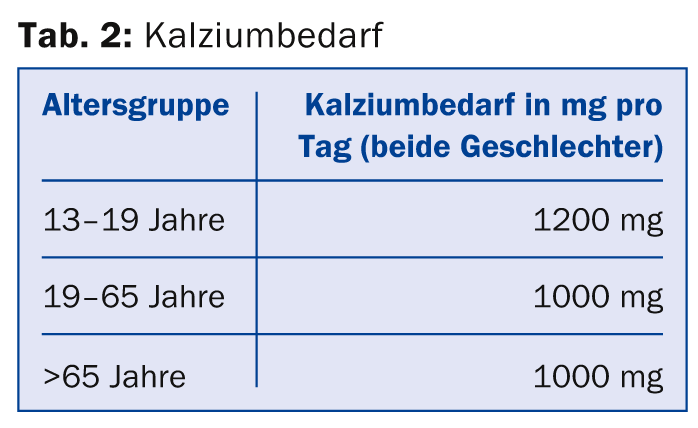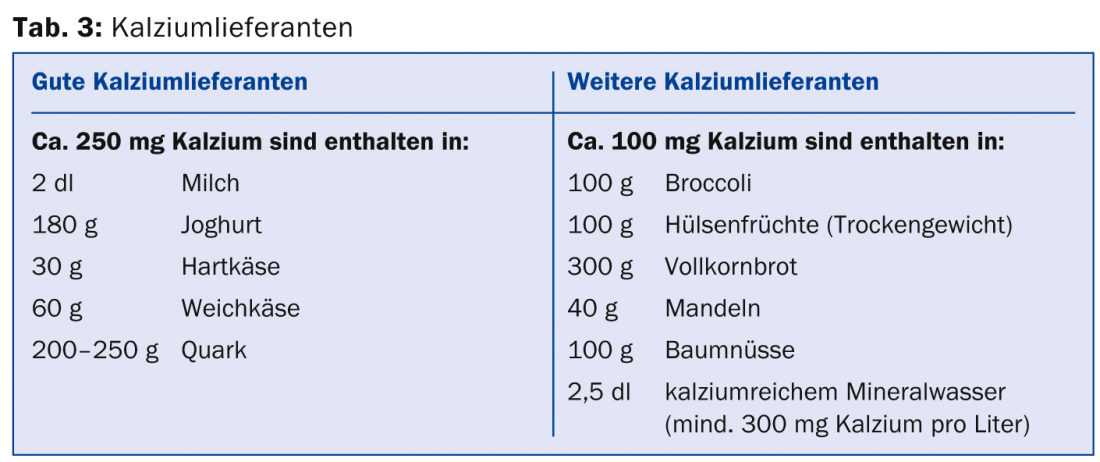In addition to factors such as exercise and genetics, diet also plays an important role in the development and therapy of the disease. of osteoporosis. Vitamin D, calcium and protein intake are elementary.
The importance of protein intake as a component of the diet should not be underestimated in osteoporosis.
Protein intake
It has not infrequently been claimed that proteins, especially of animal origin, have a negative impact on bone health. This assumption was based, among other things, on the observation of increased renal calcium excretion after protein-rich meals. Proteins increase intestinal calcium absorption, which explains the associated calciuria. Calcium is therefore not dissolved from the bones by proteins, as was previously assumed.
On the contrary, numerous studies now find a positive correlation between protein intake and bone density. The Swiss Federal Nutrition Commission EEK recommends a protein intake of at least 0.8 g/kgKG/d for older people (Tab. 1) . However, studies also show that a relatively high protein intake of up to 1.5 g/kgKG/d has a positive effect on bone density and on the risk of hip fractures.

Calcium
Calcium is the most important building block of bones. In order to reduce the risk of osteoporosis and also fractures resulting from it, both vitamin D and calcium must be supplied in sufficient quantities (Tab. 2 and 3).


General recommendations
Drinks: 1-2 liters daily, preferably in the form of unsweetened beverages, e.g. drinking/mineral water or fruit/herbal tea. Prefer mineral water rich in calcium. Consume coffee, black tea/green tea and cola drinks with restraint.
Vegetables and fruits: daily five servings of different colors, including three servings of vegetables and two servings of fruits. One serving is equal to 120 g. One serving per day can be replaced by 2 dl of unsweetened fruit or vegetable juice. Green vegetables such as broccoli, chard, spinach, various types of cabbage and leafy greens are good sources of calcium.
Cereal products, potatoes and legumes: three servings daily. For cereal products, give preference to whole grains. One serving is equivalent to 75-125 g bread/dough or 60-100 g legumes (raw) or 180-300 g potatoes or 45-75 g crispbread/whole grain crackers/flakes/flour/pasta/rice/corn/other cereal grains (dry weight).
Dairy products, meat, fish, eggs and tofu: Three servings of milk or dairy products daily. One serving is equivalent to 2 dl of milk or 150-200 g of yogurt/quark/cottage cheese/other dairy products or 30 g of semi-hard/hard cheese or 60 g of soft cheese.
In addition, one serving daily of meat, poultry, fish, eggs, tofu, quorn, seitan, cheese or cottage cheese. Alternate between these protein sources. One serving is equivalent to 100-120 g of meat/poultry/fish/tofu/quorn/ seitan (fresh weight) or 2-3 eggs or 30 g of semi-hard/hard cheese or 60 g of soft cheese or 150-200 g of curd/cottage cheese.
Oils, fats and nuts: Daily 2-3 tablespoons (20-30 g) of vegetable oil, at least half of which should be in the form of canola oil. Daily one serving (20-30 g) of unsalted nuts, seeds or kernels (such as hazelnuts, almonds, tree nuts, sesame seeds, sunflower seeds, etc.). In addition, butter, margarine, cream, etc. can be used sparingly (about 1 tbsp = 10 g/d).
Sweets, salty snacks and alcoholic beverages: Enjoy sweets, sweetened beverages, salty snacks and alcoholic beverages with moderation. Good sources of calcium are milk, yogurt or cottage cheese desserts.
HAUSARZT PRAXIS 2015; 10(2): 7











